10 Iconic Floral Still Lifes You Need to Know
Flowers have long been a central theme in still-life painting. Each flower carries its own symbolism. For example, they can represent innocence,...
Errika Gerakiti 6 February 2025
5 December 2021 min Read
All of us watched Disney cartoons in our childhood and many people re-watch them even into adulthood. However, the original plots appeared in early historical periods when tales took place only in verbal or written narrations. That is why artists started making visual images of well-known fairy tale characters. Particularly Russian artists found their inspiration in folk legends and myths only in the middle of the 19th century. Viktor Vasnetsov’s (1848-1926) and Mikhail Vrubel’s (1856-1910) artworks are the most remarkable examples of enchanting Russian tale images!
Sleeping Beauty is one of the most popular fables ever. The original story appeared in Medieval Europe and tells the story of a young princess cursed to fall asleep on her 16th birthday. Russian poet Vasily Zhukovsky published the Russian version of this tale, The Sleeping Tsarevna, in 1832. It was the translation of Charles Perrault’s La Belle au Bois Dormant and Brothers Grimm’s Dornröschen but adjusted to Russian traditions and culture.
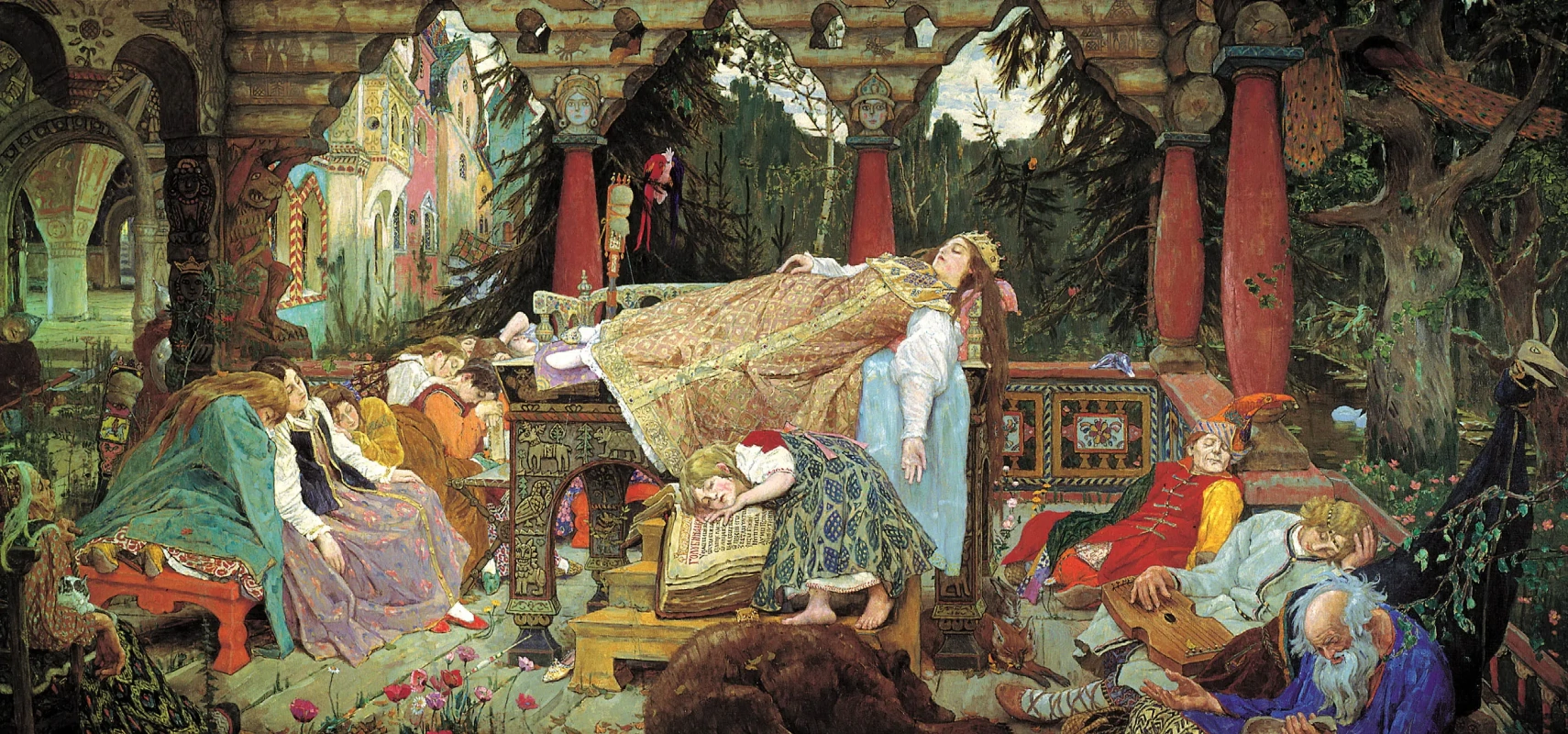
The Russian artist Viktor Vasnetsov was inspired by Zhukovsky’s The Sleeping Tsarevna. You can see the beautiful Tsarevna on a bed, clothed in a lavishly embroidered, golden Russian dress. Her long, dark braids hang down as well as her arms. There are lots of people around her who fell asleep too. Also there are a sleepy bear and fox next to the Tsarevna’s bed. In the background, the woods and rose bushes surround the old Tsar’s palace. Three hundred years had passed waiting for the hero who awakes the Sleeping Tsarevna.
By the way, there is another version of a tale about a sleeping Tsarevna written by poet Alexander Pushkin, The Tale about Dead Tsarevna, which is closer to the Grimm’s Snowhite. You may wonder if Russian poets “stole” the plots from their European colleagues? The answer is both yes and no.
In the summer of 1831 Zhukovsky and Pushkin spent their time in Tsarskoe Selo near St. Petersburg. There they entered into an unusual debate: who would better write a fairy tale in the Russian style.
Thus, the poets wrote tales based on European ones and added some details from Russian folklore. For example, the Russian Snowhite was engaged before the start of the story. Also instead of seven dwarfs, the masters of the house where Tsarevna was hiding from her jealous step-mother were twelve bogatyri (knights). Learning of the presence of a young and beautiful princess in their house, the bogatyri proposed Tsarevna become a wife to one of them. However, Tsarevna rejected all of them because of her loyalty to her fiance and became a “sister” to the bogatyri instead. Meanwhile, the prince Elisey (Tsarevna’s sweetheart) was searching for her throughout the world, asking the Sun, Moon, and Wind to show him the way to his lovely maiden. The rest of the tale remained without any alterations.
Disney’s cartoon The Princess and the Frog (2009) brings us to New Orleans, USA. The American musical film entertains spectators with cheerful dances and jazz music. So does Viktor Vasnetsov’s painting The Frog Tsarevna! The artist captured the scene of the ball at Tsar’s palace. Tsarevna is depicted dancing among court musicians with a shawl in her hand. Her flawless movements look alive and sincere. But let us briefly tell the tale of the Frog Princess now.
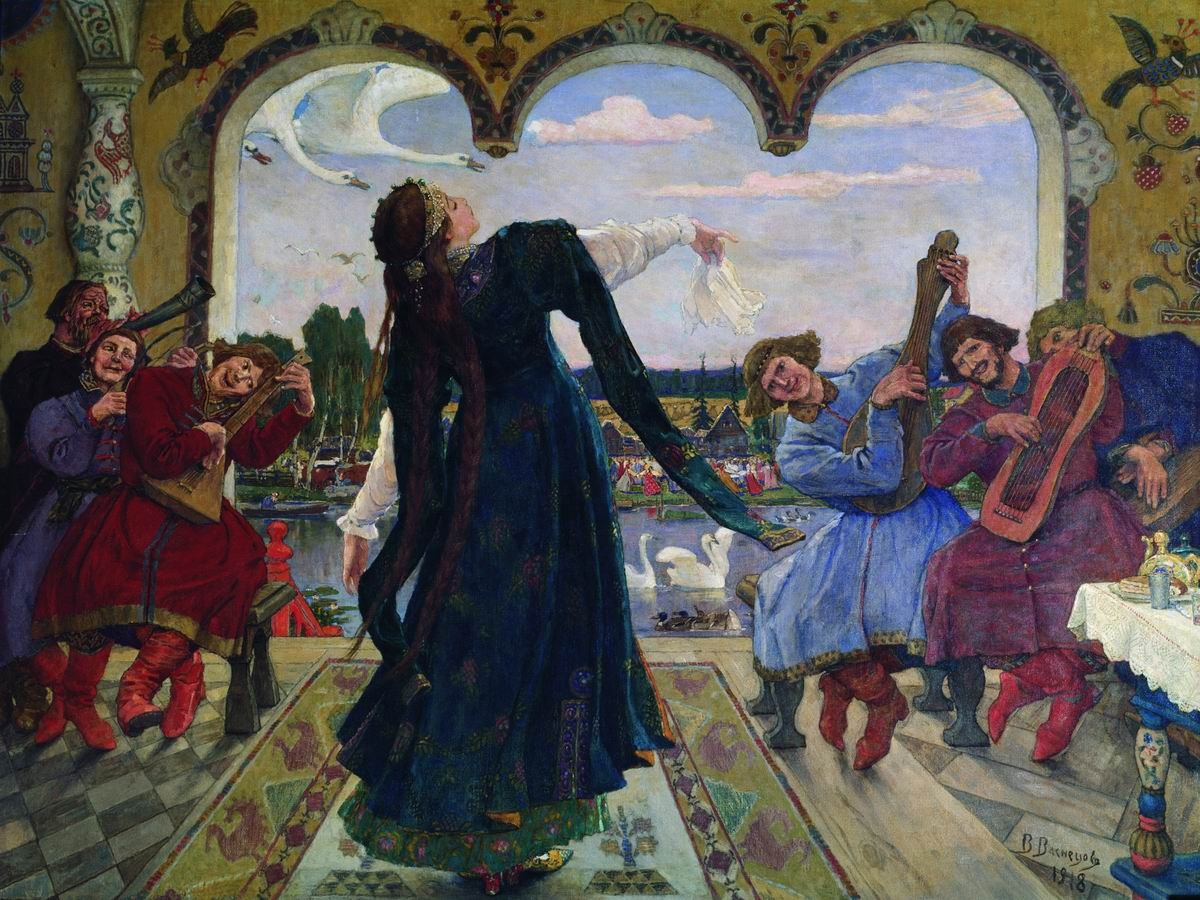
The Tsar wants his three sons to marry, so he creates a test to help them find brides. The Tsar tells each Tsarevich to shoot an arrow and according to the Tsar’s rules, each Tsarevich will find his bride where his arrow lands. A frog picks up the youngest son’s arrow.
The Tsarevich marries the frog with both disgust and regret. Meanwhile the Tsar wants to test his daughters-in-law’s abilities to cook and craft carpets. Surprisingly, the frog’s work is much better than that of other wives and the Tsar is thrilled to meet the youngest wife in person. To Ivan’s astonishment, the beautiful, cheerful, and smart Vasilisa the Wise enters the palace. It turns out that the frog is actually an enchanted Tsarevna, forced to spend three years in a frog’s skin. Ivan secretly comes back to their home and burns the frog’s skin in the fire. Had the prince been patient, the Frog Princess would have been freed but instead he loses her. He then sets out to find and free her of the curse.
The next Disney character whose alter-ego is found on a canvas of Viktor Vasnetsov is Aladdin. However, in the Russian tale, the main hero is Ivan Tsarevich, who is neglected by his older brothers and is said to be a fool. Nevertheless, his brave and kind heart help him to make friends with creatures from the magical world. For instance, Ivan helps the powerful witch, Baba Yaga, who gives him a flying carpet and shows him where to find the magic bird, Zhar Ptitsa (which is locked in a cage).

Forty years after his original painting inspired by this story, Vasnetsov painted a second version of The Flying Carpet. This time Ivan flies on the carpet with his beloved Elena the Beautiful. Reminds one of a scene from Disney’s Aladdin (1993), doesn’t it?

The sweethearts are flying away from misfortune towards a happy future. Pink and purple clouds surround them and give the canvas a romantic feel.
There are plenty of tales about mermaids and mythological sea creatures. The most popular one was written by Danish author Hans Christian Andersen. Disney visualized the story about a young mermaid who left her underwater kingdom for love.
Surprisingly, the Russian folk tale tells the story of a young musician, Sadko, who abandons the land to entertain the Sea Tsar. Satisfied with his talent, The Sea Tsar offers to let Sadko choose a bride. Russian artist, Ilya Repin, painted a scene of the bride selection. Exotic beauties in fancy dresses pass Sadko but he looks at Chernavka (a brunette girl) who stands off to the side. Repin paid attention to details and light: fish floating among the girls, seashells, starfish, and bubbles plunge us into the underwater kingdom. The soft lighting of the sea depth illuminates the figures of the brides.
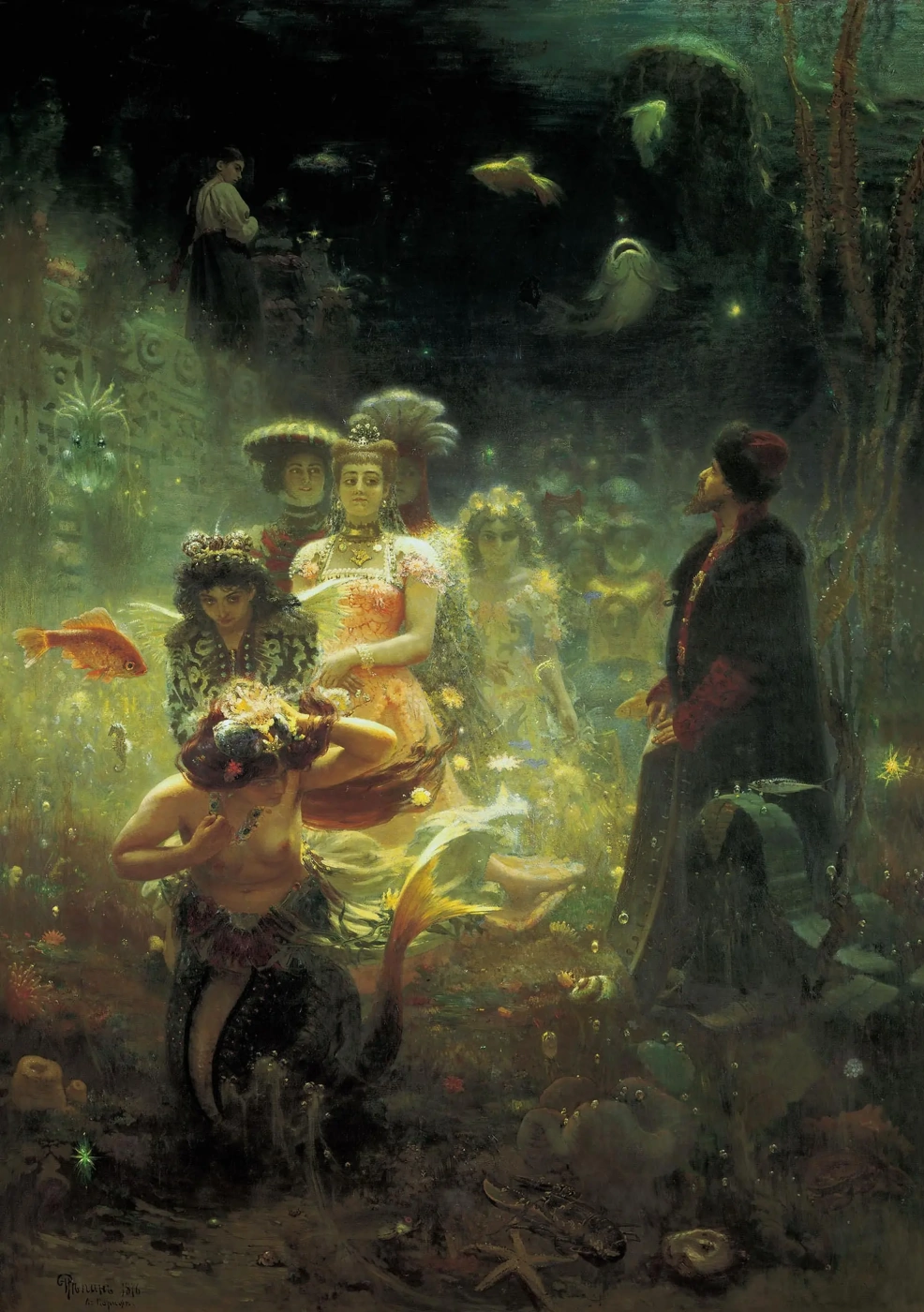
Interestingly, in Russian mythology mermaids usually do not have fishtails, but inter-finger membranes. Basically, mermaids are drowned girls who committed suicide due to unhappy love. In the painting Mermaids by the Russian painter, Ivan Kramskoy, we see a group of Ukrainian mermaids. Ivan Kramskoy found inspiration in Nikolai Gogol’s novel The May Night or The Drowned Girl. Nikolai Gogol was a famous Ukrainian writer well-known for his novels based on Ukrainian mythology. To understand the concept of the painting, read the following quote from The May Night:
In a thin silver mist flickered the light girls, as if shadows, in white as a meadow and covered by lilies of the valley, shirts.
— Nikolai Gogol, The May Night or The Drawned Girl, 1831.

The artist captured the scene of mermaids coming onto the land. According to Ukrainian tradition, mermaids can return to our world only on the Mermaid week. During this time they visit the homes where they lived before their deaths. The families of girls who probably became mermaids leave out clothes and food to treat their mermaids. Other people decorate their homes with reeds to protect themselves from “unwelcome guests.” By the way, this tradition is still alive!
What are the differences between Slavic and Western mermaids? Well, Russian mermaids do not differ from ordinary women in their beauty nor in their vocal talent. Mermaids’ faces seem the same in the painting because only moonlight reflects their beauty.
Tender, pure, and mysterious, the Swan Princess became the most remarkable character of Russian tales. Petr Tchaikovsky wrote music for the famous ballet, The Swan Lake, which is a masterpiece of Russian musical and ballet art.
You can meet The Swan Princess in The Tale of Tsar Saltan by Russian poet Alexander Pushkin. Later, Russian artist, Mikhail Vrubel, was inspired by his wife who performed the Swan role in the self-titled opera.

In this painting you can see a true Russian beauty: a pale face with big blue eyes, framed by thin dark eyebrows that express sadness. The folds of the dress have the same color and structure as her huge snow-white wings. It is impossible to guess where the transition from the feathers to the hem of her royal robe is. The mysterious and trembling figure of Swan Princess, moving away and bidding farewell to her spectators, reminds one of Tchaikovsky’s The Dying Swan.
In 2013, Disney’s cartoon Frozen won hearts around the world, especially the song Let It Go. Surprisingly, in Russian tales there is a Snow maiden too. She is the only daughter of Moroz (the freeze) and Vesna (the spring). She lives with her father, Moroz, in the forest but she dreams to live among people.
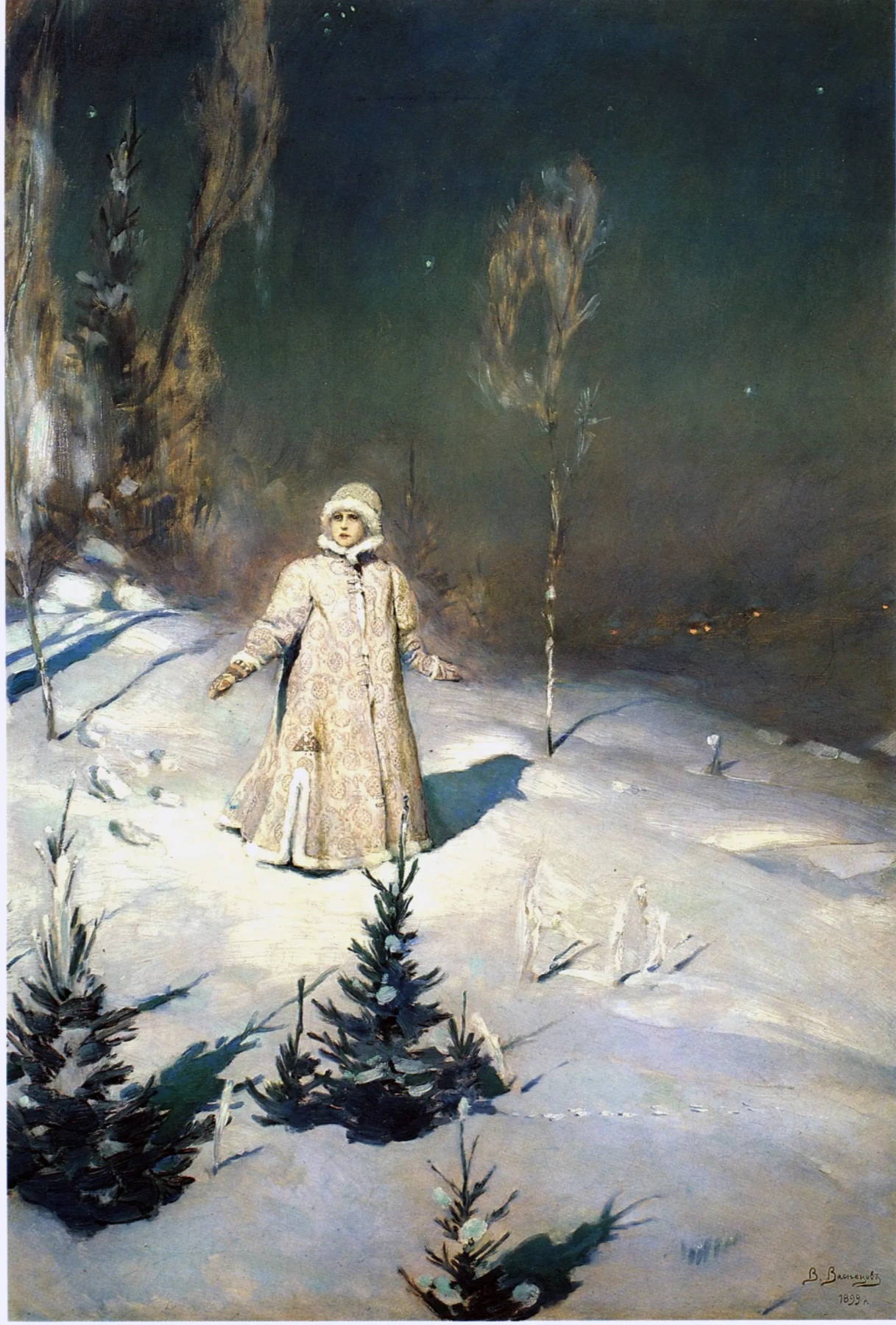
Viktor Vasnetsov depicted the moment of Snow Maiden’s escape from her father’s home. She wants to know the fire of love that could kill her frozen soul and that’s why she hesitates. Nevertheless, The Snow Maiden brings herself to learn the love and burns of its fire.
Images of women-warriors are common in many cultures and Russia is no exception. In Russian tales, a female warrior is called “polenitsa” or “bogatyrsha”. The most famous one is Vasilisa Mikulishna.
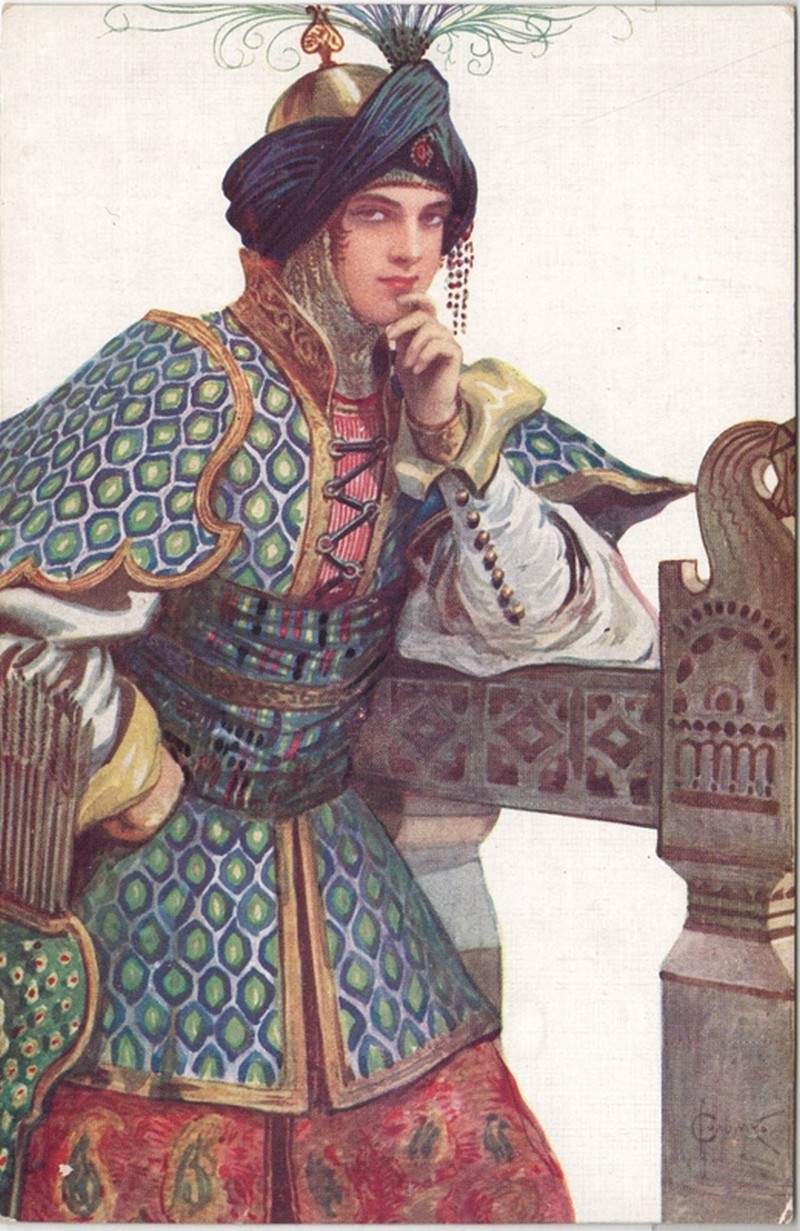
She was the wife of a boyar (nobleman) Stavr Godinovich of Chernihiv, Ukraine. Once, at a ball at prince Vladimir’s palace in Kyiv, Stavr brags of his beautiful and strong wife Vasilisa. The jealous Vladimir locks Stavr away and orders that Vasilisa come to Kyiv. Loyal friends warn the young polenitsa of the danger, so she makes a plan to rescue her husband. Vasilisa, clothed in a male oriental dress, poses as a Tatar ambassador.
However, Prince Vladimir’s niece, Zabava Putyatichna, immediately realizes that she is a masked woman. Vladimir tries to test this guest to find out whether he is a man or a woman. Vasilisa cheats him and asks to marry Zabava Putyatichna. At the wedding feast, the Tatar ambassador complains that the “musicians are bad” and commands that Stavr join in the celebration. Next the ambassador persuades Vladimir to give him Stavr and finally, shows everyone her true identity. Vasilisa Mikulishna overwhelmed her enemies with her cunning and strength. The happy spouses then return to Chernihiv and lived happily ever after.
Irina Marinova
DailyArt Magazine needs your support. Every contribution, however big or small, is very valuable for our future. Thanks to it, we will be able to sustain and grow the Magazine. Thank you for your help!